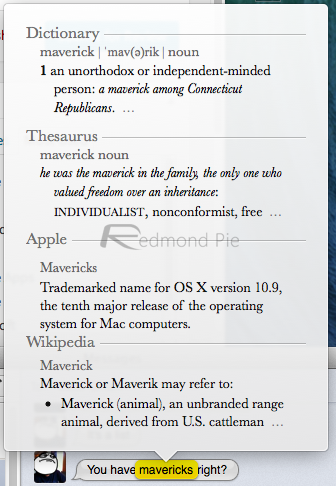Over the last couple of months I’ve been chipping away at creating an add-on dictionary for the Dictionary application on Mac. Running Mac OS X 10.4.11 (Tiger). If you don't see the app in Launchpad, type its name in the search field at the top of the screen. Or swipe right or left with two fingers on your trackpad to show the next or previous page. Press and hold the Option (⌥) key, or click and hold any app until the apps jiggle.
- Recent versions of Mac OS X will offer suggestions and automatically correct stuff if you’ve misspelled a word. If you tap the spacebar when you see a suggestion like the one above, your Mac.
- Dictionary app on the Mac Your Mac comes with an app called 'Dictionary', which you find in your Applications folder. However, by default only a few dictionaries are activated. You first need to go to the Dictionary app preferences (DictionaryMenu Preferences) and activate the foreign language dictionaries that you need.
Also found in: Dictionary, Thesaurus, Medical, Financial, Acronyms, Wikipedia.
Mac OS X
(operating system)Mac OS X
(Mac OS 10) The current operating system from Apple for the Mac family. Starting in the fall of 2016, Version 10.12 uses the rebranded 'macOS' moniker and not OS X. See macOS and Sierra.OS X Server was introduced in 1999, and the client version came out in 2001. Based on Unix and featuring an entirely redesigned user interface, OS X was a major departure from the previous OS 9 system. For the first time, the rich set of Unix commands became available to all Mac developers (A/UX was an earlier Unix OS for the Mac but was not widely used).
OS X added protected memory, pre-emptive multitasking, multithreading and symmetric multiprocessing (SMP) to the Mac world. The heart of OS X is the open source, POSIX-compliant Darwin kernel, which includes an enhanced BSD 4.4 operating system and Mach 2.5 microkernel. See HFS.
Legacy Software
Prior to Mac OS X 10.5 (Leopard), OS X ran legacy OS 9 and earlier applications via its Classic software, which was a full copy of OS 9 that ran as an OS X process. Classic was not preloaded on new Macs, but was available for installation from the system disks.
In 2006, Apple switched from the PowerPC to the Intel platform, and Classic support was dropped in the Intel version of OS X. However, PowerPC applications could run on Intel Macs via an emulator (see Rosetta).
Programming Environments
There have been five programming interfaces (APIs) for writing Mac OS X applications. Cocoa is the native OS X interface, derived from OpenStep. Carbon is used for applications that can run on both OS X and earlier Mac OS machines, and Classic is the API prior to Mac OS X. Programs can also be developed in Java and BSD. See OpenStep and Cocoa.
Faster Cats!
Mac OS X versions were internally code-named after jungle cats. Starting with Version 10.2 (Jaguar), the animals became the official product name until Version 10.9 (see below). See Rhapsody and Bonjour.
Want to thank TFD for its existence? Tell a friend about us, add a link to this page, or visit the webmaster's page for free fun content.
Mac Dictionary Download

Link to this page:

Excuse My Spelling, My Dictionary is set to American English!
Well, over on the U.S. side of the Atlantic it isn’t such a big problem but over here in Europe all to often the Mac OS X spelling dictionary language is set to U.S. English by default.
The British & Irish guys just don’t like spelling colour without the ‘u’ and ‘socialise’ with a ‘z’.
On top of that, any one of us in Europe or the U.S. speak multiple different languages and would like to chose the spelling dictionary language on the fly.
This article goes about explaining the two most common ways of changing the system-wide Mac OS X spelling dictionary language.
The first method looks at when you’re using the spellcheck inside an application such as TextEdit or Pages. The second method is a more permanent system wide change and takes place in the System Preferences.
Mac Os X Pages Dictionary Download
I’m doing this on a MacBook running Mac OS X 10.6.4 Snow Leopard.
Read on for the details.
Changing the Spellcheck Dictionary Language From Inside The Application
To make this change from within a specific application such as Pages or TextEdit do the following:
- In your application, click Edit > Spelling & Grammar > Show Spelling & Grammar or press CMD+: on the keyboard.
- When the Spelling & Grammar window appears, select your language from the drop down menu at the bottom and then click the red X to close the window again.
This change will only last as long as you keep TextEdit open. After you re-open the application, the spelling dictionary language will reset back to the system default. Let’s talk about changing the system default spelling dictionary language now.
Note: This is often called something else in other applications, e.g., in Pages it’s called simply ‘Spelling…‘
Changing the Mac OS X System Default Spellcheck Dictionary Language
Changing the system default spelling dictionary language is just as easy. Follow these few easy steps:
- Open System Preferences; one way is to click the System Preferences icon on your Dock. If you can’t see this go ahead and open Applications > Utilities > System Preferences
- In the Personal Preferences row (top row), click Language & Text.
- Now click the Text tab at the top
- On the right side, you should now see a field called Spelling. Select your preferred language from here.